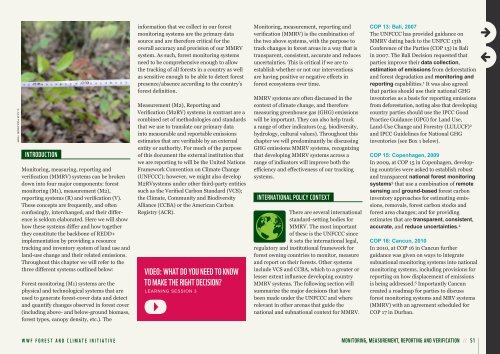WWF Guide to Building REDD+ Strategies
WWF Guide to Building REDD+ Strategies
WWF Guide to Building REDD+ Strategies
You also want an ePaper? Increase the reach of your titles
YUMPU automatically turns print PDFs into web optimized ePapers that Google loves.
© JULIE PUDLOWSKI / <strong>WWF</strong><br />
intRoduCtion<br />
Moni<strong>to</strong>ring, measuring, reporting and<br />
verification (MMRV) systems can be broken<br />
down in<strong>to</strong> four major components: forest<br />
moni<strong>to</strong>ring (M1), measurement (M2),<br />
reporting systems (R) and verification (V).<br />
These concepts are frequently, and often<br />
confusingly, interchanged, and their difference<br />
is seldom elaborated. Here we will show<br />
how these systems differ and how <strong>to</strong>gether<br />
they constitute the backbone of <strong>REDD+</strong><br />
implementation by providing a resource<br />
tracking and inven<strong>to</strong>ry system of land use and<br />
land-use change and their related emissions.<br />
Throughout this chapter we will refer <strong>to</strong> the<br />
three different systems outlined below:<br />
Forest moni<strong>to</strong>ring (M1) systems are the<br />
physical and technological systems that are<br />
used <strong>to</strong> generate forest-cover data and detect<br />
and quantify changes observed in forest cover<br />
(including above- and below-ground biomass,<br />
forest types, canopy density, etc.). The<br />
information that we collect in our forest<br />
moni<strong>to</strong>ring systems are the primary data<br />
source and are therefore critical for the<br />
overall accuracy and precision of our MMRV<br />
system. As such, forest moni<strong>to</strong>ring systems<br />
need <strong>to</strong> be comprehensive enough <strong>to</strong> allow<br />
the tracking of all forests in a country as well<br />
as sensitive enough <strong>to</strong> be able <strong>to</strong> detect forest<br />
presence/absence according <strong>to</strong> the country’s<br />
forest definition.<br />
Measurement (M2), Reporting and<br />
Verification (M2RV) systems in contrast are a<br />
combined set of methodologies and standards<br />
that we use <strong>to</strong> translate our primary data<br />
in<strong>to</strong> measurable and reportable emissions<br />
estimates that are verifiable by an external<br />
entity or authority. For much of the purpose<br />
of this document the external institution that<br />
we are reporting <strong>to</strong> will be the United Nations<br />
Framework Convention on Climate Change<br />
(UNFCCC); however, we might also develop<br />
M2RVsystems under other third-party entities<br />
such as the Verified Carbon Standard (VCS);<br />
the Climate, Community and Biodiversity<br />
Alliance (CCBA) or the American Carbon<br />
Registry (ACR).<br />
video: WHat do you need <strong>to</strong> knoW<br />
<strong>to</strong> make tHe RiGHt deCiSion?<br />
LEARNING SESSION 3<br />
Moni<strong>to</strong>ring, measurement, reporting and<br />
verification (MMRV) is the combination of<br />
the two above systems, with the purpose <strong>to</strong><br />
track changes in forest areas in a way that is<br />
transparent, consistent, accurate and reduces<br />
uncertainties. This is critical if we are <strong>to</strong><br />
establish whether or not our interventions<br />
are having positive or negative effects in<br />
forest ecosystems over time.<br />
MMRV systems are often discussed in the<br />
context of climate change, and therefore<br />
measuring greenhouse gas (GHG) emissions<br />
will be important. They can also help track<br />
a range of other indica<strong>to</strong>rs (e.g. biodiversity,<br />
hydrology, cultural values). Throughout this<br />
chapter we will predominantly be discussing<br />
GHG emissions MMRV systems, recognizing<br />
that developing MMRV systems across a<br />
range of indica<strong>to</strong>rs will improve both the<br />
efficiency and effectiveness of our tracking<br />
systems.<br />
inteRnational PoliCy Context<br />
There are several international<br />
standard-setting bodies for<br />
MMRV. The most important<br />
of these is the UNFCCC since<br />
it sets the international legal,<br />
regula<strong>to</strong>ry and institutional framework for<br />
forest owning countries <strong>to</strong> moni<strong>to</strong>r, measure<br />
and report on their forests. Other systems<br />
include VCS and CCBA, which <strong>to</strong> a greater or<br />
lesser extent influence developing country<br />
MMRV systems. The following section will<br />
summarize the major decisions that have<br />
been made under the UNFCCC and where<br />
relevant in other arenas that guide the<br />
national and subnational context for MMRV.<br />
COP 13: Bali, 2007<br />
The UNFCCC has provided guidance on<br />
MMRV dating back <strong>to</strong> the UNFCC 13th<br />
Conference of the Parties (COP 13) in Bali<br />
in 2007. The Bali Decision requested that<br />
parties improve their data collection,<br />
estimation of emissions from deforestation<br />
and forest degradation and moni<strong>to</strong>ring and<br />
reporting capabilities. 1 It was also agreed<br />
that parties should use their national GHG<br />
inven<strong>to</strong>ries as a basis for reporting emissions<br />
from deforestation, noting also that developing<br />
country parties should use the IPCC Good<br />
Practice Guidance (GPG) for Land Use,<br />
Land-Use Change and Forestry (LULUCF) 2<br />
and IPCC <strong>Guide</strong>lines for National GHG<br />
inven<strong>to</strong>ries (see Box 1 below).<br />
COP 15: Copenhagen, 2009<br />
In 2009, at COP 15 in Copenhagen, developing<br />
countries were asked <strong>to</strong> establish robust<br />
and transparent national forest moni<strong>to</strong>ring<br />
systems 3 that use a combination of remote<br />
sensing and ground-based forest carbon<br />
inven<strong>to</strong>ry approaches for estimating emissions,<br />
removals, forest carbon s<strong>to</strong>cks and<br />
forest area changes; and for providing<br />
estimates that are transparent, consistent,<br />
accurate, and reduce uncertainties. 4<br />
COP 16: Cancun, 2010<br />
In 2010, at COP 16 in Cancun further<br />
guidance was given on ways <strong>to</strong> integrate<br />
subnational moni<strong>to</strong>ring systems in<strong>to</strong> national<br />
moni<strong>to</strong>ring systems, including provisions for<br />
reporting on how displacement of emissions<br />
is being addressed. 5 Importantly Cancun<br />
created a roadmap for parties <strong>to</strong> discuss<br />
forest moni<strong>to</strong>ring systems and MRV systems<br />
(MMRV) with an agreement scheduled for<br />
COP 17 in Durban.<br />
<strong>WWF</strong> FOREST AND CLIMATE INITIATIVE moni<strong>to</strong>RinG, meaSuRement, RePoRtinG and veRiFiCation // 51

















